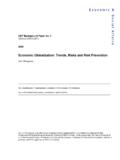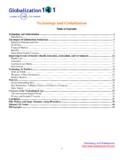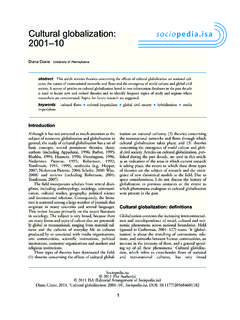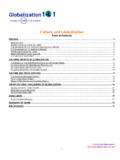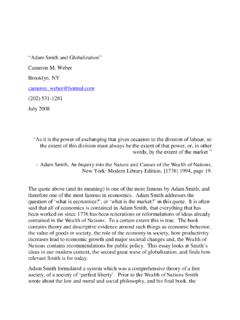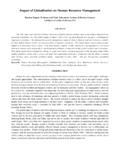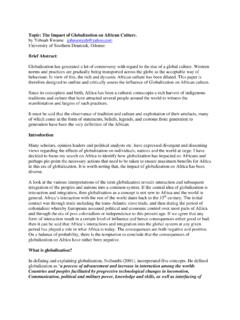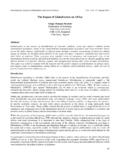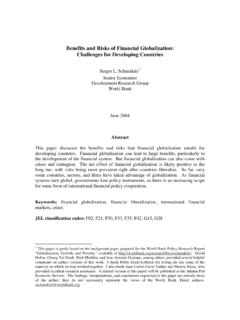Transcription of Globalization and infectious diseases: A review of …
1 UNICEF/UNDP/World Bank/WHO Special Programme for Research & Training in Tropical Diseases (TDR) Social, Economic and Behavioural (SEB) ResearchSPECIAL TOPICS and infectious diseases: A review of the linkages TDR/STR/SEB/ "Special Topics in Social, Economic and Behavioural (SEB) Research" series are peer-reviewed publicationscommissioned by the TDR Steering Committee for Social, Economic and Behavioural Research. For further information please contact: Dr Johannes Sommerfeld Manager Steering Committee for Social, Economic and Behavioural Research (SEB) UNDP/World Bank/WHO Special Programme for Research and Training in Tropical Diseases (TDR) World Health Organization 20, Avenue Appia CH-1211 Geneva 27 SwitzerlandE-mail: and infectious diseases.
2 A review of the linkagesLance Saker,1 MSc MRCPK elley Lee,1 MPA, MA, Cannito,1 MScAnna Gilmore,2 MBBS, DTM&H, MSc, MFPHMD iarmid Campbell-Lendrum, on Global Change and HealthLondon School of Hygiene & Tropical MedicineKeppel Street, London WC1E 7HT, UK2 European Centre on Health of Societies in Transition (ECOHOST)London School of Hygiene & Tropical MedicineKeppel Street, London WC1E 7HT, UKTDR/STR/SEB/ World Health Organization on behalf of the Special Programme for Research and Training in Tropical Diseases 2004 All rights use of content from this health information product for all non-commercial education, training and information purposes isencouraged, including translation, quotation and reproduction, in any medium, but the content must not be changed and fullacknowledgement of the source must be clearly stated.
3 A copy of any resulting product with such content should be sent toTDR, World Health Organization, Avenue Appia, 1211 Geneva 27, Switzerland. TDR is a World Health Organization (WHO) execut-ed UNICEF/UNDP/World Bank/World Health Organization Special Programme for Research and Training in Tropical information product is not for sale. The use of any information or content whatsoever from it for publicity or advertising,or for any commercial or income-generating purpose, is strictly prohibited. No elements of this information product, in part orin whole, may be used to promote any specific individual, entity or product, in any manner designations employed and the presentation of material in this health information product, including maps and other illus-trative materials, do not imply the expression of any opinion whatsoever on the part of WHO, including TDR, the authors or anyparties cooperating in the production, concerning the legal status of any country, territory, city or area, or of its authori-ties.
4 Or concerning the delineation of frontiers and or depiction of any specific product or commercial enterprise does not imply endorsement or recommendation by WHO,including TDR, the authors or any parties cooperating in the production, in preference to others of a similar nature not men-tioned or views expressed in this health information product are those of the authors and do not necessarily reflect those of WHO,including , including TDR, and the authors of this health information product make no warranties or representationsregard-ing the content, presentation, appearance, completeness or accuracy in any medium and shall not be held liable for any dam-ages whatsoever as a result of its use or application.
5 WHO, including TDR, reserves the right to make updates and changes with-out notice and accepts no liability for any errors or omissions in this regard. Any alteration to the original content brought aboutby display or access through different media is not the responsibility of WHO, including TDR, or the , including TDR, and the authors accept no responsibility whatsoever for any inaccurate advice or information that is pro-vided by sources reached via linkages or references to this health information authors wish to thank colleagues at the Centre on Global Change and Health, London School of Hygiene and TropicalMedicine, for their helpful advice in the writing of this paper.
6 We are particularly grateful to Professor David Bradley for hisdetailed comments and expertise in reviewing the final and layout: Lisa SchwarbTABLE OF CONTENTSLIST OF TABLES, FIGURES AND BOXES ..vABBREVIATIONS AND ACRONYMS ..viEXECUTIVE SUMMARY .. What is Globalization ? .. Global burden of infectious disease .. AND THE CHANGING NATURE OF infectious disease .. Globalization AND infectious disease .. World Trade Organization and multilateral trade agreements .. The global trade in food .. The global trade in pharmaceuticals ..155 GLOBAL ENVIRONMENTAL CHANGE AND infectious disease .
7 Global climate change .. Global warming .. Global weather change .. Vulnerability to global climate changes .. Water supply .. Large dams .. Small water projects .. Displacements, disruptions, distant effects and migrations .. Deforestation and land clearance .. Deforestation, land clearance and new or emerging infections .. Vector-borne infections .. Pharmacological implications of loss of biodiversity ..346 GLOBAL DEMOGRAPHIC CHANGE AND infectious Globalization and population Trends in population mobility .. The causes of population mobility.
8 Population mobility and infectious disease .. Refugees and displaced persons .. Long-term migration .. Migration to low-income countries .. Migration to high-income countries .. The growth in urban populations and the influence of Globalization .. Urbanization and infectious disease ..40iiiiv7 GLOBAL TECHNOLOGICAL CHANGE AND infectious disease .. Information and communication technologies .. Transportation technologies: the growth in short-term travel .. The growth in short-term travel .. Short-term travel and infectious diseases .. Transport of goods and infectious diseases.
9 Medical technologies ..498 CONCLUSIONS ..51 REFERENCES ..55 Special Topics No. 3 Globalization and infectious diseases: A review of the linkages vBOXESBox 1:Transmission of infectious diseases ..9 Box 2: infectious diseases and the natural environment ..10 Box 3: Preventing and treating human infections ..11 Box 4:Projections of the health impacts of global environmental change ..17 Box 5:The scientific evidence for global environmental change ..21 Box 6:Global climate change and vector-borne diseases ..22 Box 7:Climate effects on vectorial capacity, basic reproductive number, vector abundance and distribution.
10 24 Box 8: El Ni o and infectious diseases ..25 Box 9: Infection and water projects along the Nile river ..28 Box 10:Malaria ..32 Box 11:Dengue ..42 Box 12: infectious disease and the Haj ..48 FIGURESF igure 1:Alternative scenarios of future development and associated climate change developed by the IPCC ..18 Figure 2:Global average near-surface temperatures, 1860-1999 ..19 Figure 3:The global average temperature rise predicted from the unmitigated emissions scenario, and the emission scenario which stabilizes CO2concentrations at 750 ppm and at 550 ppm ..20 LIST OF TABLES, BOXES AND FIGURESACL anthroponotic cutaneous leishmaniasisAVLanthroponotic visceral leishmaniasisCMEWHO Commission on Macroeconomics and HealthDALY disability adjusted life yearDNAdeoxyribonucleic acidENSOEl Ni o Southern OscillationEWEextreme weather eventsFAOFood and Agriculture OrganizationFDIforeign direct investmentGATSG eneral Agreement on Trade in ServicesGATTG eneral Agreement on Tariffs and TradeGBDSG lobal Burden of disease StudyGDPgross domestic productGISgeographical information systemHIV/AIDS human immunodeficiency virus/acquired immunity deficiency










